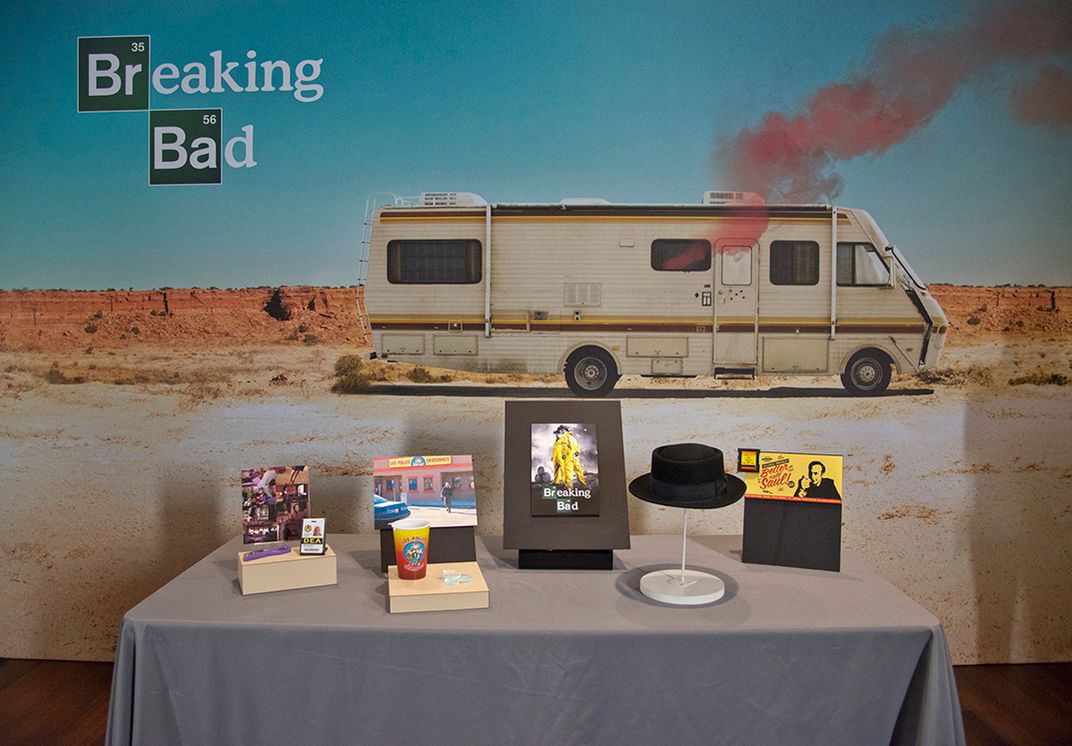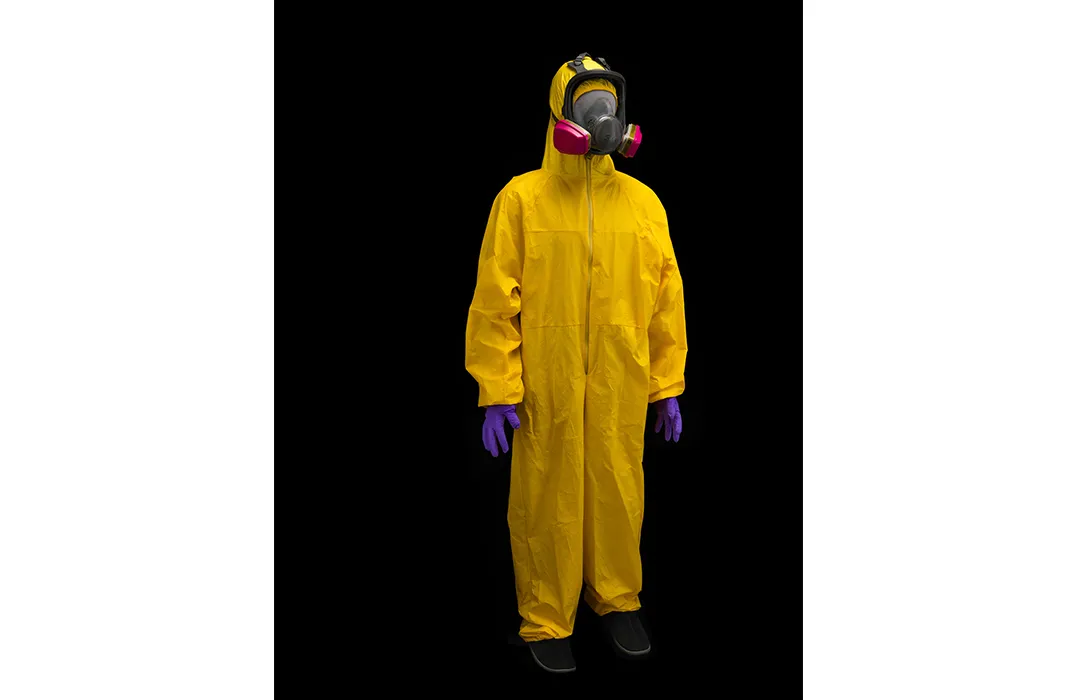How Crystal Meth Made it Into the Smithsonian (Along with Walter White’s Porkpie Hat)
The wildly popular television show, depicting the dark side of the American Dream, reflects on the struggles of a recession-era middle class
:focal(654x270:655x271)/https://tf-cmsv2-smithsonianmag-media.s3.amazonaws.com/filer/88/b8/88b83806-f47c-404e-b21b-0d1d99c252d0/4279068248web.jpg)
A murderous drug lord delivered crystal meth to the National Museum of American History earlier this week, along with Hazmat suits and gas masks. And curators welcomed him with open arms.
The drugs, which turned out to be rock candy with blue dye, and the meth-making paraphernalia are props and costumes from the acclaimed television drama “Breaking Bad.” Actor Bryan Cranston, who played the show’s terminally ill, financially strapped chemistry teacher Walter White, arrived with members of the show’s cast, crew and studio executives to make the delivery.
“‘Breaking Bad’ is one of the finest examples of the transformative power of storytelling,” the museum’s director John L. Gray said at a donation ceremony on November 10, 2015 that also included the signature porkpie hat worn by White when he was using the alias “Heisenberg,” and which he borrowed from renowned German scientist Werner Heisenberg, as well as paper cups with the logo from Los Pollos Hermanos restaurant, the DEA identification card of Hank Schrader, a purple corkscrew used by Hank’s wife Marie, and a “Better Call Saul” matchbook from White’s crooked lawyer Saul Goodman.
The Emmy-award-winning series, which aired on AMC from 2008 to 2013, followed the downward spiral of White, who decides to make and distribute methamphetamine to secure his family’s financial future.
According to entertainment curator Dwight Blocker Bowers, who spent three years wooing executives at Sony Pictures Television, “the series used White’s trajectory from family provider to drug kingpin to reflect the moral ambiguity of contemporary society and the dark side of the American Dream.”

“If you had told me in 2005 that props from our show would eventually find their way to the Smithsonian,” says the series creator and executive producer Vince Gilligan, “I would have said that you were using too much of Walter White’s product.”
Cranston, 59, spoke fondly of his cast mates, but disclosed that he does not miss the show or his Walter White role. He likened his contentment to having eaten a beautiful meal with which he is perfectly satiated and then being offered a second dessert. “If you dive into that, it almost ruins the experience that you had,” he says. “And I don’t know if my personage could take another dessert after the sweet ride that ‘Breaking Bad’ was.”
Cranston impulsively modeled the Heisenberg hat, while nervous curators looked on because the hat, at this point in the ceremony, was now a museum artifact.
He admitted that it felt strange to have it on after more than 2 years. He also pointed out the differences in the two versions of Tyvek suits used on the show. Apparently, the first version presented a sound issue due to excessive rustling, so costume designers developed a satin-like, quieter suit. “But neither of them could breathe, so it was like being in a sauna,” Cranston says.
Thirty-seven year-old actor Aaron Paul, who played White’s former student Jesse Pinkman loudly concurred. “These things were so ungodly hot,” he says.
Paul also spoke of his gratitude to Gilligan and other producers for selecting him for the role of Jesse. “Thank you for hiring me because it changed my life, it changed everyone’s lives involved with ‘Breaking Bad.’ Who knew meth could really bring us to the Smithsonian,” he says.
Many of the other actors echoed their appreciation for the gigantic boost the show has given to their careers. Jonathan Banks, 68, played the character Mike Ehrmantraut, head of corporate security for the Los Pollos Hermanos restaurant and money laundering operation.
“Listen, as good as we are all, and I won’t be coy about that, we are also wildly, wildly lucky. There are a lot of good actors out there, who never ever get this opportunity,” he says; “Not on this level, not this good fortune.”

RJ Mitte, age 23, who played Walter White’s son felt similarly. “‘Breaking Bad’ has given me so many things. So many opportunities to work and to grow,“ he says. Currently, he is acting and modeling in international campaigns for GAP and other top-tier designers.
Mitte who was born with a mild case of cerebral palsy, slowed down his speech, exaggerated his movements and learned to walk with crutches, so he could portray Walter White Jr. with a more pronounced case of the disease.
Fans dubbed him “The Breakfast King” because so many of his scenes took place at the breakfast table. “I don’t really ever eat breakfast, but I love that I was titled that,” he says. “It is definitely entertaining to see what people gravitate toward and what people latched on to.”
As the show progressed, the fan base continued to multiply. The final episode racked up an impressive 10.3 million viewers. David Pierson, an associate professor of media studies at the University of Southern Maine says that the show had enormous cultural significance. In the fall of 2013, he edited a book with other academics studying the phenomenon titled Breaking Bad: Critical Essays on the Contexts, Politics, Style, and Reception of the Television Series.
Pierson believes that one reason for the show’s popularity is that “it reflects a lot of the pressures on the middle class, who are struggling, particularly post 9-11 and through the great recession of 2008, to make ends meet and to plan for their future. And that future is not always bright.”
He also points out that because the episodes were available for streaming on Netflix, many viewers who had not started watching the show initially, were able to catch up on previous episodes in time to see the final seasons as they were released.
Ryan White, age 31, of Springfield, Virginia, started watching during the second season, after catching up on Netflix. He found it compelling, because, “you were watching as they just kept stepping deeper and deeper into hell. At first it was Walter’s personal hell, but then it engulfed his whole family, friends and associates. There were seminal moments, when things happened. . . .particularly to Gus, Gayle and Hank. . .that you just couldn't believe.”
Nineteen year-old Geoff Zhou of Dayton, Ohio, began both high school and watching “Breaking Bad” at the same time. He binge-watched the first three seasons and found that he liked the writing and the story line. “Every time Walt was backed into a corner, he would find some way to get out and then you had to wait until next week to find out what happened and I was hooked, I couldn’t stop, I was so invested,” he says. Zhou watched it at home alone, but would text his friends as things happened because they were usually watching too.
Rob Williams, a 48 year-old from Worcester, Mass, screened the show with his wife Maureen after streaming the first three seasons to catch up. They found it “fascinating to watch how Walter, who started out as a semi-normal guy, just went farther and farther to the dark side.” Williams also found the plot twists were totally intriguing. “Whereas some shows are pretty predictable, you just didn’t know which way they were going to go with Breaking Bad.”
The museum does not have immediate plans to display the new “Breaking Bad“ acquisitions, but an upcoming exhibition, drawing from the theater, music, sports and entertainment collections and exploring American culture, is in development for 2018.
/https://tf-cmsv2-smithsonianmag-media.s3.amazonaws.com/accounts/headshot/Lucy_Harvey_151120_1745_WEB.jpg)


/https://tf-cmsv2-smithsonianmag-media.s3.amazonaws.com/accounts/headshot/Lucy_Harvey_151120_1745_WEB.jpg)